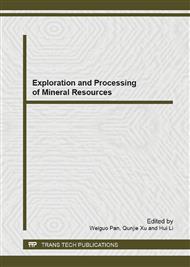p.487
p.497
p.503
p.510
p.517
p.522
p.529
p.535
p.542
The Experimental Study on the Changes of Polymer Solution`s Rheological Property in Immediate Vicinity of Wellbore
Abstract:
In order to study the near wellbore area of perforated well and after adsorption detention flow variation of rheological property of polymer solution , artificial physics and artificial cylindrical core model 1:10 are used to do experiments. Results indicate that natural degradation processes of polymer solutions, it is plummeting rapidly within 20 day, then reach stability. Near bore the constant speed when the polymer injection and a variable speed injection, the decreasing amplitude of apparent viscosity caused by the shear factor is approximately 22.5%. In the process of adsorption and detain, injecting 0.8pv polymer, model began to produce polymer. About injecting 2.6pv , adsorption and detain reach stability.
Info:
Periodical:
Pages:
517-521
Citation:
Online since:
December 2013
Authors:
Price:
Сopyright:
© 2014 Trans Tech Publications Ltd. All Rights Reserved
Share:
Citation:


